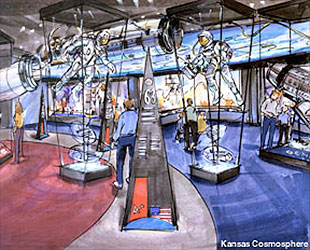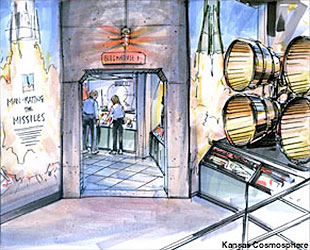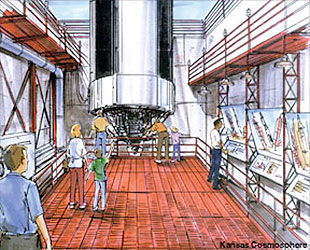Update for June 18, 2005 – Bathed in blue light, a statue of U.S. President John F. Kennedy sits in a rocking chair. Opposite him, red-lit, standing and fist-raised high is a full body bust of Soviet Premier Nikita Khrushchev.
Visitors to the Kansas Cosmosphere and Space Center's Mollett Early Spaceflight Gallery, which opened Saturday (June 18) to the public, pass beneath these two figures as they enter, setting a stage for the Cold War-driven space race they will witness inside.
Click on thumbnails to enlarge
More photographs below.
The contrast between red and blue — U.S. and USSR — is emphasized throughout the new gallery, which presents a multi-media look at the early space exploration efforts of the two adversarial nations. The disparity between color-lit areas is bridged by the proximity of the artifacts to each other. Never before in their respective histories, have the separately-devised space vehicles and spacesuits been so close for comparison.
The Mollett Gallery houses the flown two-person Gemini X spacecraft, a flown Russian Vostok spacecraft similar to that ridden by Yuri Gagarin, and an engineering model of the spacewalk-capable Voskhod, as well as suits used for those spacecraft.
The gallery will be expanded in late 2006 with the return of Virgil "Gus" Grissom's Mercury spacecraft, Liberty Bell 7, to the Cosmosphere. The capsule is presently completing a six-year nationwide museum tour.
"The Mollett Early Spaceflight Gallery is really an anchor for the entire Hall of Space Museum," says Cosmosphere President Jeff Ollenburger. "By focusing on the incredible early days of human space exploration, we see a starting point for everything that is happening in space exploration today."
In addition to the display of the historic vehicles, visitors are taken back in time, to the blockhouse and launch pad at Cape Canaveral, Florida.
Peering through the Blockhouse 5/6 periscope, museum-goers can watch films of rocket launches – witnessing the same images NASA flight controllers saw during the early 1960s. They can then step outside for a launch encounter of a different kind.
Standing within a representation of the Cape's Titan rocket pit, visitors can hear Mission Control chatter and rocket countdown sounds of the Mercury and Gemini launch-day activities. They can then climb up the gantry next to the engines of the 100-foot Titan rocket that propelled Gemini spacecraft into the stratosphere.
Back inside, the exhibit leads viewers to the Hutchinson museum's Apollo exhibit, which includes Odyssey, Apollo 13's command module. The successful U.S. lunar landing program brought the space race to a close.
To formally open the new gallery, the Cosmosphere held a reception on Friday for its sponsors, members and board of directors. Addressing the guests were Roger Launius, Space History Chair at the Smithsonian's National Air and Space Museum; Laura Shepard Churchley, the daughter of the late astronaut Alan Shepard; and Mercury astronaut Scott Carpenter.
"This is a spectacular display of space flight history." said Carpenter.
Click on thumbnails to enlarge
November 19, 2004 – When the Mollett Early Spaceflight Gallery opens to the public in the spring of 2005, visitors to the Kansas Cosmosphere and Space Center will have a rare chance to view spacecraft and spacesuits that began the space race between the United States and the Soviet Union.
The Cosmosphere, located in Hutchinson, Kansas, today announced that $750,000 in private donations had allowed construction to begin on the new gallery. Two-thirds of the needed funds were gifted by local residents Clarence and Mary Jane Mollett, for whom the new gallery is named.
The Molletts also arranged a $1.5 million deferred gift to the Cosmosphere's Foundation. The combined donation of $2 million represents one of the largest gifts in the history of the museum.
"As long-time supporters of the museum, Mary Jane and I have never been more impressed with all the activity and future plans for the Cosmosphere," Clarence Mollett said.

American and Soviet spacesuits will be displayed within the new Mollett Early Spaceflight Gallery. (Kansas Cosmosphere) |
The 4,000 square foot (370 square meter) gallery will bring some of the Cosmosphere's most notable artifacts to the museum floor. It will include historical archives from both the U.S. and Soviet programs, including spacesuits used during the Mercury and Gemini, and Vostok and Voskhod missions.
The gallery will feature the flown Gemini X spacecraft, a flown Russian Vostok, a full-size engineering model of the Voskhod, and will ultimately be the home of Virgil "Gus" Grissom's Liberty Bell 7 spacecraft after the completion of its national tour in 2005.
"When Liberty Bell 7 returns, the Cosmosphere will be one of only three locations in the world to have flown Mercury, Gemini and Apollo spacecraft," Jeff Ollenburger, president and CEO, said.

An artist concept depicts the entrance to the Cosmosphere's new Early Spaceflight Gallery blockhouse. (Kansas Cosmosphere) |
"From an exhibition standpoint, this is an important project for us that in many ways will be the anchor gallery for the entire museum. By focusing on the incredible early days of human space exploration, we can see the starting point for everything that is happening in space today."
Fundraising for the Early Spaceflight Gallery will continue through the completion of the project in spring 2005, and a list of all donors giving $1,000 or more will be permanently displayed at the gallery's entrance.
To date, corporate contributions have also been made by American Packaging, TSW Products, First National Bank, Fee Insurance, Kwik Shop, Inc. and the Pipeline Testing Consortium, all of Hutchinson, and the Cessna Foundation in Wichita.

The Mollett Early Spaceflight Gallery will lead visitors outside to view the display of a Titan rocket. (Kansas Cosmosphere) |
"A project of this size takes a tremendous amount of support and we are very pleased that so many of our long-time friends and supporters of the Cosmosphere from both Hutchinson and the surrounding area have helped make this project a reality," Ollenburger said.
